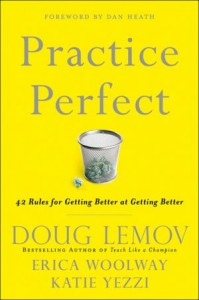Practice Perfect
 Having trained salespeople for twenty years, I’d like to think I know a thing or two about effective training. But having read Practice Perfect: 42 Rules for Getting Better at Getting Better
Having trained salespeople for twenty years, I’d like to think I know a thing or two about effective training. But having read Practice Perfect: 42 Rules for Getting Better at Getting Better, by Doug Lemov, Erica Woolway and Katie Yezzi, I also realize that I can further help my students and my clients by taking some of my training sessions up to a whole new level.
By now it’s well-known that the most important factor in mastery of a skill is thousands of hours of practice. Taking this idea one step further, what you need to consistently get better is deliberate practice, which is about repeatedly identifying specific areas that need improvement, practicing to get to a certain standard, getting immediate feedback and then practicing again until you get it right. This book takes the idea of deliberate practice one step further, by showing specifically how to isolate the key areas that need improvement, how to practice, and how to give and receive feedback. It’s organized into 42 rules for “getting better at getting better”.
The key theme of the book is that practice does not make perfect—it makes permanent. If you practice the right things wrong, or the wrong things right, you will permanently encode substandard performance. In other words, practicing the same thing over and over in the wrong way will only make you better at doing it wrong. Or, if you practice the wrong skill, you will get very good at something that will not contribute to your success. So, you first have to figure out what to practice by analyzing the domain you want to succeed in and then identify and prioritize the key skills that will have the greatest impact. Then, devise the proper drills to practice to a measurable standard so that you can encode success.
I judge if a book is worth reading by how many useful and immediately practical ideas I take from it, and Practice Perfect has given me at least a dozen. In a general sense, I plan to incorporate less scrimmaging and more drilling into the skills portions of my training sessions. For example, sales training teaches a variety of skills and then usually culminates in a realistic role play or presentation, after which participants are critiqued and then sent on their way. The problem with realistic training is that each new skill may only be practiced once, if at all. Drilling is intended to be unrealistic, so that it can provide multiple concentrated opportunities to practice each skill. As the authors say, use scrimmaging to assess, and drilling to improve.
While this may sound like common sense, it can actually be hard to sell to potential clients. In a tough economy everyone is justifiably tight with their training dollars and time spent away from the field, so they try to cram as much into shorter training sessions as they possibly can. The question that must be answered by sales executives or training professionals is: is it better to learn a lot of things imperfectly, or a few critical things perfectly?
One way out of that conundrum, as the authors note, is to plan training sessions meticulously, in order to get as much possible effectiveness out of every single minute. They note that in the NFL it has now become common to have “pre-game” meetings to prepare for practices, and that review of practice tapes is as important as game tapes. This idea is actually amazingly easy to follow even for full-time professionals who don’t have the luxury of much dedicated practice time. Almost everyone carries a tablet device or smartphone that takes video, and imagine how your skill level could improve if you would rehearse a sales presentation or questioning sequence before an important sales call.
Another way out of the conundrum is to provide a proper framework and standard for the most important skills and then help managers institutionalize the practice of practice within their organizations. In today’s fiercely competitive war for talent, it may be better to have a strong culture of practice and then hire for coachability and willingness to learn, as opposed to demonstrated skill.
The authors are education experts and have developed their techniques and rules for training classroom teachers, but they also weave in plenty of examples from sports[1] and business, and make it very clear that the ideas and techniques are universal to the proper learning of a skill. The first half of the book is devoted to individual skill improvement, and the second half offers practical advice for institutionalizing perfect practice within the organization.
Whether you are an executive seeking ways to improve the performance of your employees, Little League coach on the weekends, or a motivated self-learner, Practice Perfect is the book for you.
[1] In fact, it appears that the legendary basketball coach John Wooden is their patron saint, and you could certainly do worse than that in a book about practice.



